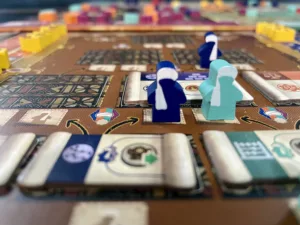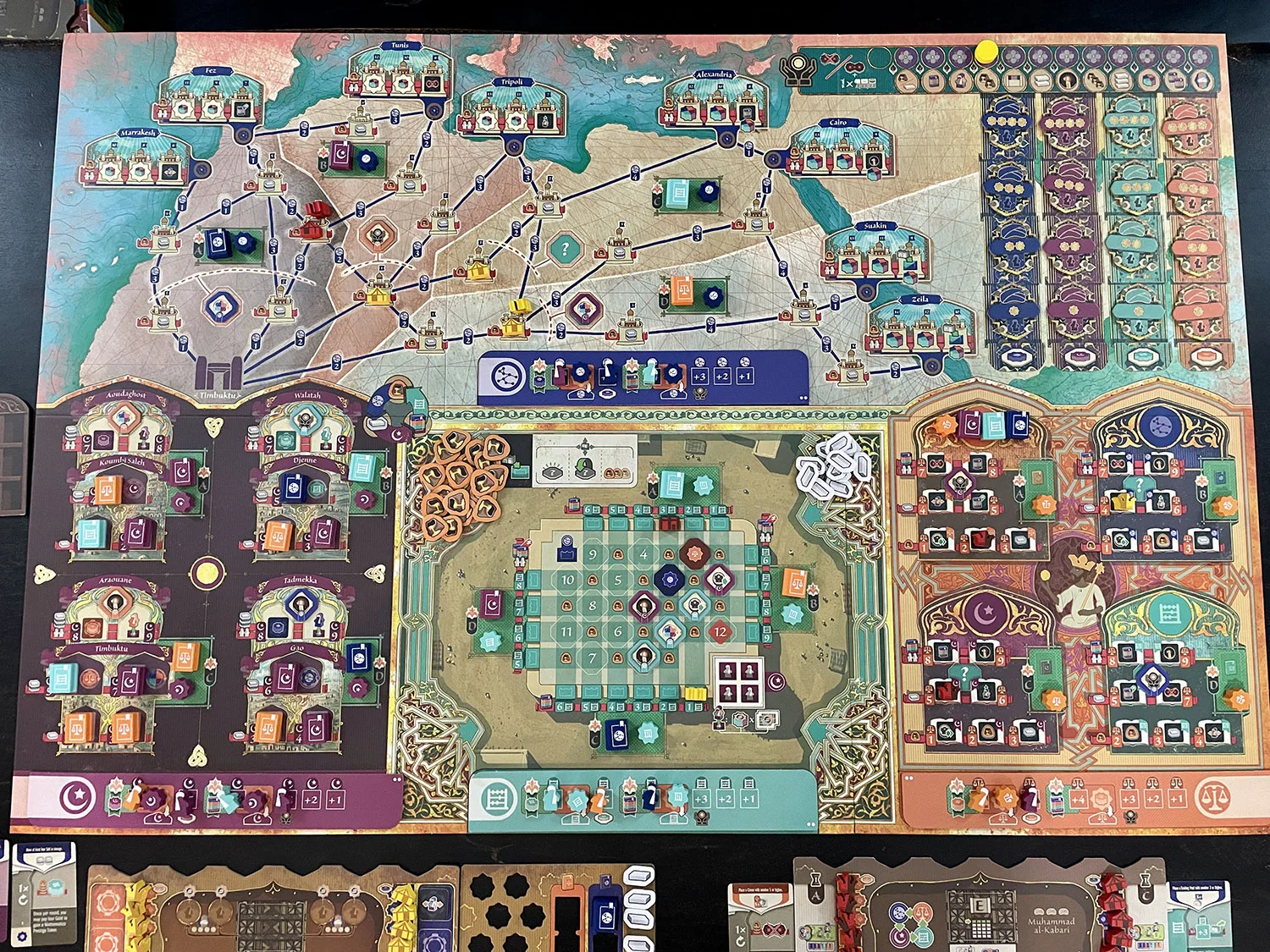 These days board game consumers are seeing more designers branch out to highlight historical and cultural importance rather than retell the same tales of land and cash grabs by merchants and aristocrats. These new themes still fit comforably within the Euro design space, lending a familiarity of mechanisms while these newer themese are learned and enjoyed. It’s not often that a game brings an entirely new facet to the industry. We’re all in a cycle of shared knowledge and incremental advancement.
These days board game consumers are seeing more designers branch out to highlight historical and cultural importance rather than retell the same tales of land and cash grabs by merchants and aristocrats. These new themes still fit comforably within the Euro design space, lending a familiarity of mechanisms while these newer themese are learned and enjoyed. It’s not often that a game brings an entirely new facet to the industry. We’re all in a cycle of shared knowledge and incremental advancement.
With Sankoré: The Pride of Mansa Musa, designers Fabio Lopiano and Mandela Fernández-Grandon tackle the return of Mansa Musa to the city of Timbuktu and the resulting determination to develop a prestigious university. And while this sounds like a co-op premise, players find themselves engaged in a scholarly competition to bring the most prestige to this academic setting.
Gameplay Overview:
The easiest way to parse the somewhat daunting game board is to break it down into its areas of study: astronomy, theology, mathematics, and law. These four disciplines drive a system of interconnectivity and an ever-increasing shared knowledge value that benefits everyone at the table. Before we get too deep, it must be noted that Sankoré plays from one to four players with an approximate playtime of two to three hours.

Each discipline interacts with each other. Salt gained from astronomy can be used to pay for studies in theology, which provides books that power mathematics, which provides gold for astronomy. And law provides bonus tokens that boost the power of each of these. Each discipline also has a randomly populated queue of students from each discipline waiting to be enrolled in your classes.
Players begin with basic classes in each of the four disciplines. They then select a combination of class/student/book from an initial draft to provide asymmetry and possible direction (also aided by objective cards). Player boards feature four rows of classes that get more advanced as they progress, like a tech tree, as well as discipline supplies and slots for bonus skill tokens. A separate resource board houses prestige, books, salt, gold, and inspiration, all of which have a fixed inventory space.
Books become an important resource as they determine the value of prestige at the end of the game. Anytime a player must pay a book resource, it is added into a central library board on one of three shelves (six shelves on the reverse side of the board). Each shelf becomes a majority battle as players vie to balance their gained prestige with each row’s book placement.

On their turn, players take two different actions (out of five options). They also have the option to take bonus actions using their inspiration tokens to gain a book or shift their students into new classes. This is an important option, because students who’ve taken a class are promoted along a pre-determined line to the next row of class options.
Players can enroll a student from any of the four queues and add them to the bottom of that portion of their player board matching the student discipline. This increases the shared knowledge available to all players in the region they were removed from. These queues also feature majority scoring opportunities that benefit players who’ve added their supplies for the matching discipline by taking the next action we’ll discuss.
Teaching a class allows players to advance their students into more advanced classes and to interact with the main board. Each class provides a discipline matching bonus, though students from different disciplines can be taught any class. Each region provides a knowledge value, and as players teach classes and add their supplies to the main board, their own personal knowledge value increases. An action is typically more valuable as knowledge increases.

Each area of the board has an associate discipline supply on the player board. Tents for astronomy, crowns for law, mosques for theology, and walls for mathematics. These get added to their respective sections during the teach-a-class action and allow players to gain benefits and complete for majorities. Each discipline has four distinct sections within it that provide book and prestige bonuses when majority scorings are triggered during an enroll student action.
Another action allows players to establish new classes onto their player boards. For the cost of a matching book, players choose from a selection of options from each discipline. And as students advance, their potential prestige value increases for those moments when you want to use an action to graduate them.
The final action interacts with a favor track that increases when players teach their introductory classes (or via other bonuses). Favors provide more powerful bonuses the further along the track you’ve traveled, but at the cost of adding a favor token to their prestige supply. These tokens cover up value space for prestige tokens, thus limiting potential end-game scoring opportunities if not managed properly.

Game Experience:
Sankoré has the look of a heavy Euro game, but after a play or two, its daunting visuals start to coalesce into a distinguishable space. This is still on the heavier (heaviest?) side of a medium-weight game, but that has more to do with the scoring conceptualization during play than the actual actions taken. In fact, actions can be very fast when all you are doing is graduating a student and then taking the favor action. There is still room for analysis paralysis for players who may have a hard time with all the iconography on display.

The theme isn’t as integrated as the setting. That said, the premise provides a fresh avenue to explore action selection and scoring manipulation. The artwork by Ian O’Toole helps with grounding the theme more than the mechanisms, as you never truly feel like competing scholars helping to improve the university. The true sense of collective improvement comes from the increase of shared knowledge, as every enroll-student action could benefit others more than yourself.
Each of the four disciplines require different payments and provide different rewards. That said, they are all ultimately areas of access based on your ability to line up the correct student to the correct type of class, all while being mindful of the available knowledge to take the action. It’s a game of wanting to explore all four areas but knowing that your objective cards encourage you to focus in specific areas to gain added prestige and boosted abilities.
The interconnectivity on display is excellent. Players can push hard into one area but miss out on so much. Leaving law behind may see other players gain bonus tile benefits. Focusing too much on traveling in the astronomy area, or adding mosques to the theology area, sees players strapped for gold or salt resources which can only be gained by taking on more favor restrictions.

As such, players need to time their actions properly to benefit the most from available knowledge as well as their amassed bonuses. Easy right? Well, now you must consider which students are studying in your classrooms and which classrooms you’ve lined up for them to advance into. There is as much strategy on display as there is tactical shifting. Sankoré increases the tension by making resource gathering meaningful, only to add more decision bandwidth by limiting available inventory space.
The real star of the show here is the scoring. As players gain prestige from finishing objectives and majority scorings and many other avenues, they must be ever-mindful of the library. All players have a hand in which disciplines will be worth the most at the end of the game. The most books in a shelf row gains two points, whereas the second most gains one point (per prestige token). Third place? Nothing. So, keeping your discipline relevant in the library can be a constant struggle and provides a lot of subtle tension.
Though I’m happy with most of this design, there are a few things that I want to mention. The first to be mindful of is the fact that some of the cardboard components have shown a tendency to warp slightly, which requires some dedication to keeping them straight. As for gameplay, I do not feel that there’s enough time to truly take advantage of the bonus tiles, so they feel less impactful than other areas of the board. I also feel that a couple of rules complexities, such as adding students and/or walls to mathematics from other areas, feel unnecessary; they added rules overhead without enough payoff.

Final Thoughts:
I’ve certainly buried the lede here. Sankoré provides an excellent puzzle for those willing to take their time to parse through the initial moment of overwhelming table presence and components. It provides a Euro design that isn’t stuffed full of tracks and victory points. Instead, it provides a heavier mid-weight experience that requires time to learn and master without making your brain melt. I’d go so far as to say that this is one of the better designs at this weight and genre that we’ve seen in a while. Lopiano and Fernández-Grandon have graduated with honors after this collaboration.
Final Score: 4.5 stars – Sankoré proves that there is much to be gained from shared knowledge and intensive studies.
 Hits:
Hits:
• Bookshelf and majority scoring
• Mechanism interconnectivity
• Shared knowledge concept
• Quick player turns
Misses:
• Bonus tile impact
• Setup time and table space
• Minor complexity additions






















